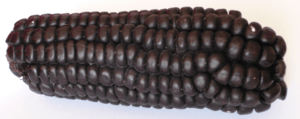Purple corn facts for kids
Purple corn is a special type of corn that has a beautiful deep purple color. It's also known as maíz morado in Spanish. This unique corn first came from South America, especially from the Andes mountains. People in countries like Peru, Bolivia, and Ecuador have been growing it for a very long time. An old name for this corn in the Quechua language is "k'culli."
What is Purple Corn Used For?
Purple corn is very popular in Peru. People use it to make a tasty drink called chicha morada. To make it, they boil the purple corn kernels with things like pineapple, cinnamon, and cloves. Then they add sugar. It's a refreshing drink!
Another sweet treat made with purple corn is mazamorra. This is a type of pudding that's also very popular. In Bolivia, a warm, thick drink called Api is made from a special kind of purple corn called "Kuli." It's like a hot smoothie.
Why is Purple Corn Purple?
The amazing purple color of this corn comes from natural substances called anthocyanins. These are special pigments found in many plants, fruits, and vegetables. They give blueberries, red cabbage, and purple grapes their colors too!
Anthocyanins are a type of polyphenols, which are good for you. The main anthocyanin in purple corn is called cyanidin 3-O-glucoside. It makes up most of the purple color you see.
Scientists have studied purple corn to learn more about these colorful compounds. They found that the location where the corn grows can affect how many anthocyanins it has. Interestingly, the husks of the purple corn plant have even more anthocyanins than the kernels themselves! This means that even parts of the plant we don't usually eat could be useful.
See also
 In Spanish: Maíz morado para niños
In Spanish: Maíz morado para niños


